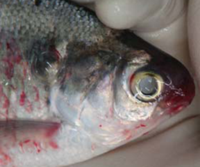
Photo from wikipedia
The Anthropocene has brought substantial change to ocean ecosystems, but whether this age will bring more or less marine disease is unknown. In recent years, the accelerating tempo of epizootic… Click to show full abstract
The Anthropocene has brought substantial change to ocean ecosystems, but whether this age will bring more or less marine disease is unknown. In recent years, the accelerating tempo of epizootic and zoonotic disease events has made it seem as if disease is on the rise. Is this apparent increase in disease due to increased observation and sampling effort, or to an actual rise in the abundance of parasites and pathogens? We examined the literature to track long-term change in the abundance of two parasitic nematode genera with zoonotic potential: Anisakis spp. and Pseudoterranova spp. These anisakid nematodes cause the disease anisakidosis and are transmitted to humans in undercooked and raw marine seafood. A total of 123 papers published between 1967 and 2017 met our criteria for inclusion, from which we extracted 755 host-parasite-location-year combinations. Of these, 69.7% concerned Anisakis spp. and 30.3% focused on Pseudoterranova spp. Meta-regression revealed an increase in Anisakis spp. abundance (average number of worms/fish) over a 53 year period from 1962 to 2015 and no significant change in Pseudoterranova spp. abundance over a 37 year period from 1978 to 2015. Standardizing changes to the period of 1978-2015, so that results are comparable between genera, we detected a significant 283-fold increase in Anisakis spp. abundance and no change in the abundance of Pseudoterranova spp. This increase in Anisakis spp. abundance may have implications for human health, marine mammal health, and fisheries profitability.
Journal Title: Global change biology
Year Published: 2020
Link to full text (if available)
Share on Social Media: Sign Up to like & get
recommendations!